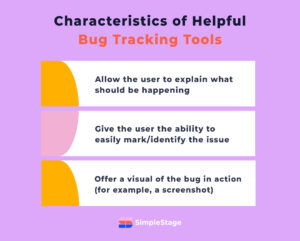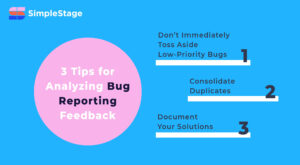No website is completely issue-free for life. And if you’re still in the development stage, your new build may be far from perfect. From unclickable buttons to inconsistent page layouts, bugs happen — and the best solution is to catch them all.
Of course, you can’t do it alone. Unless you have dozens of devices on multiple versions of each operating system (not to mention unlimited time), there are bound to be bugs that you don’t even experience yourself. Inviting other users, whether they be clients or team members, to test out a site is the best way to uncover all the problems you need to solve.
That’s where a bug reporting tool like SimpleStage comes in. But in order to understand the power of bug trackers and how to analyze them on SimpleStage, we first need to explore what bugs are in the first place.
What Is a Bug Exactly?
In the world of website development, bugs are errors in code that manifest as unexpected results on your website. Examples of bugs on websites may include:
- Web pages not loading on specific browsers
- Text disappearing behind another design feature
- A checkout button leading customers back to your shopping cart
Just like real-life pests, bugs on your site can simply be annoying to deal with. But the more severe a bug is, the more likely it is to have a direct impact on revenue and customer satisfaction. Even for small businesses, a single minute of downtime can cost up to $427.
Again, website bugs can be difficult to track because you can’t have your eyes on every possible device. And beyond that, since bugs are unintended, they can appear where you least expect them.
What Is Bug Reporting?
Bug reporting is the process of documenting exactly what’s going wrong, then sending that information to the development team members who are in charge of the fix. While one bug may happen on a certain device, it doesn’t mean it will happen again on another. Reproducing bugs can be time consuming, frustrating, and a challenge for both parties involved.
To avoid confusion about reproducing bugs or sending details through multiple email chains, SimpleStage is designed to make this process seamless and easy to comprehend.
Using our software, you can easily send your clients a link to their staged or live website with our bug tracker and feedback collection tools ready to go. The client or QA team member will then have the ability using our bug tracking toolbar to draw, annotate, and mark any issues they may see.
On your end, you will have all the details necessary to fix their bug, including their screen width and browser. This limits the back-and-forth, so you can move toward an issue-free website launch or resolve existing errors on a live page.

Characteristics of Successful Bug Tracking
Anyone can track bugs or problems with a website. Whether it’s helpful or not is a whole other story. Bug tracking must be clear and concise, while offering information that helps developers locate the issue on the backend. This information may include the user’s device and screen size, the URL the bug appeared on, and a complete description of the bug itself.
It’s not always possible to get clients to take the time to collect all of the information, which is why we created the feedback collection tools in SimpleStage. Using our software, those details are automatically collected for the user when they mark or annotate an issue.
Beyond providing the right technical information, successful bug tracking will:
- Allow the user to explain what should be happening
- Give the user the ability to easily mark/identify the issue
- Offer a visual of the bug in action (for example, a screenshot)
But understandably, not all users intuitively know what details they need to provide. Bug reporting software makes it easier for users to help you.
Whether they’re performing a complete website audit or simply browsing through your site, clients and stakeholders can use bug reporting tools like SimpleStage to instantly capture technical details. This way, they can focus on explaining what they know off the top of mind: the issue that occurred.
How to Analyze Website Bugs With SimpleStage
To help you improve your bug tracking and feedback collection, you can use SimpleStage to get the information you need. SimpleStage gives you a more precise understanding of what’s going wrong and what needs to be fixed. This information will help your team be more productive with the web project and ultimately give you a happier customer.

3 Tips for Analyzing Feedback
A great bug reporting tool can make the issues or feedback you receive easier to decipher and more actionable. But even with the best bug reporting software in the world, web teams should keep in mind these three key tips for analyzing bugs to avoid costly mistakes.
1. Don’t Immediately Toss Aside Low-Priority Bugs
Every issue should receive your full attention. Even if a bug may seem small at first, it can be a sign of larger issues to come. You don’t have to immediately jump into action when a bug is low on your to-do list, but reading each note thoroughly can help you spot trends as new reports come in.
Plus, if users are designating the level of priority themselves, they may not realize the bigger technical implications of a given issue.
2. Consolidate Duplicates
Staying organized is essential when you’re smoothing out the issues on a website. If your bug tracking tool doesn’t already help you do so, make sure you’re consolidating any duplicate reports, so you don’t have two members of your web team working on resolutions at once.
3. Document Your Solutions
Don’t forget to record your solutions and responses to bug reports as you go. After all your hard work, you don’t want to bump into the same situation again, only to have to redo the bug-fixing process. Building a knowledge base can help you quickly determine if a new bug can be fixed with an old solution, saving you time.
Looking for a way to improve the way your agency tracks website feedback and bugs?
SimpleStage is the only platform that unifies the client experience by providing tools to help agencies collect website feedback, design feedback and collect content.
Learn MoreImprove Your Site With Bug Reporting Software
Bug reporting software like SimpleStage can be a game changer in your website development process. SimpleStage provides the data you need to identify bugs faster and clarify the feedback your clients give. By helping your team members (and users outside your team) to contribute through high-quality reporting, you can eliminate your blindspots and squash more bugs than ever before.
With SimpleStage, each of your incoming reports will be significantly easier to analyze, which means faster resolutions and fewer costly errors.

